|
Peeps into the past
|
A tranquil traffic-free street
scene from the late 19th century as a load of hay is carted down North
Street. The building on the left with the dormer windows was demolished to
make way for shop premises, now the Aroma Spice Indian restaurant. |
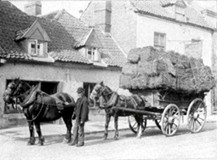 |
|
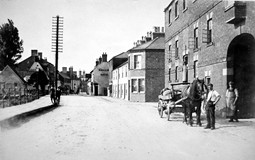 |
Our streets
were once free of traffic except for an occasional horse and cart
such as the one seen here waiting to unload outside Wherry's
warehouse in South Street, part of which is now demolished and the
rest converted into flats. |
|
The streets
were invariably quiet a hundred years ago and this tranquil scene in
West Street shows two ladies enjoying an afternoon walk, one of them
with a baby in a perambulator, while the only traffic to be seen is
horse-drawn. |
 |
|
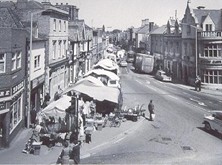 |
|
A
move to bring the market back to the streets two years ago was
shelved and this picture shows why. In past times, stalls
blocked the pavements and created a traffic hazard which is
why it was given its present location behind the town hall. |
|
|
|
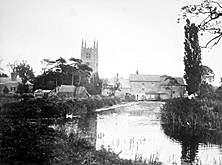 |
|
Our
local river, the Bourne Eau, was once regarded as a beauty
spot, wide and flowing and largely free of weeds and algae in
this scene of tranquillity from a century ago showing
Baldock's Mill and the Abbey Church in the distance. |
|
|
 |
The Ostler
memorial dominated the market place in past times, a striking stone
edifice in the shape of a water fountain that worked only
spasmodically and has now been removed to the town cemetery because
of increasing traffic flows in what is now the town centre.
|
|
Eastgate,
over 100 years ago, quiet and secluded with horses and carts as the
only traffic and perhaps a cycle or two. The width of the Bourne Eau
at this point is quite surprising with small bridges crossing to
give access to riverside properties. |
 |
|
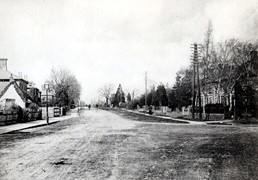 |
North Road,
over 100 years ago, quiet and secluded with no sign of a motor car.
Telegraph poles can be seen along the pavement on the right and the
thatched roof on the extreme left is that of Cuckoo Bush Cottage,
demolished in 1960. |
|
This rare
mediaeval mud and stud cottage at No 15 Bedehouse Bank was a Grade II
listed building but was demolished with the approval of local
councillors and so inspired the formation of the Civic Society in
1977 to protect our heritage in the future. |
 |
|
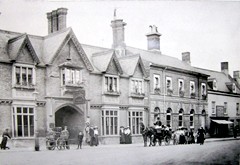 |
|
The
town centre has changed dramatically in the past 100 years as
the motor car has replaced horse drawn transport which was
once a familiar part of the street scene in Victorian times. |
|
|
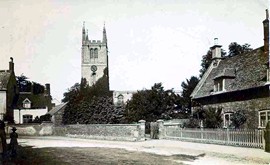 |
|
The main
change to South Street in the past 100 years is the increase in
traffic flows but Church Walk which runs past the Abbey Church
remains a haven of peace and solitude and is well worth a visit. |
|
|
Heavy snow
usually causes disruption to everyday life but during the late
winter of 1916 conditions were so bad that most services were halted
as the town was cut off for several days and this scene from West
Street was typical of the entire district. |
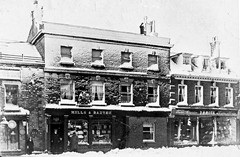 |
|
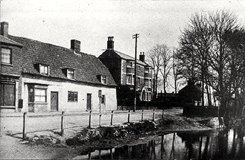 |
Although
the distinctive house where the motor racing pioneer, Raymond Mays,
once lived still dominates Eastgate most of the old cottages have
been demolished to make way for new housing developments. |
|
 |
Housing
began spreading outwards in Bourne a century ago and West Road
became one of the most popular places to live although here only two
or three new homes had been built in what was then little more than
a country lane. |
|
Modern
traffic flows regularly choke South Street on the southern approach
to the town but a century ago the road was usually deserted except
for the occasional stray dog and a shop assistant hopefully awaiting
customers. |
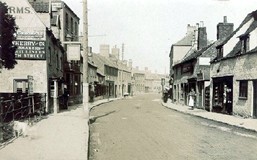 |
|
 |
|
Our
most important secular building is the Red Hall, now as a
Grade II listed property after having survived a century of
vibrations from passing steam locomotives and freight wagons
when it was used as the town's railway booking office and
stationmaster's house. |
|
|
|
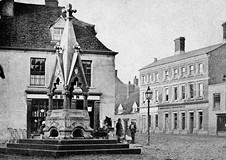 |
|
No public
figure has ever been given such as grand
memorial as the drinking fountain erected in the market place 150
years ago to the memory of the landowner and philanthropist John Lely Ostler and restored in 2009 at a cost of £9,000. |
|
|
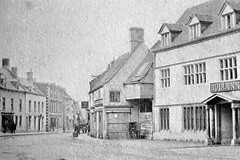 |
One of the
earliest views of the town centre shows a quaint shop on the spot
now occupied by the Lloyds TSB bank and a coaching arch on the front
of the Burghley Arms, then known as the Bull, all signs of the
changing street scene. |
|
Standing in
the middle of the town centre today would be a foolhardy thing to do
yet there were no dangers from passing traffic during the late 19th
century when the market place, as it then was, reflected the
unhurried pace of life. |
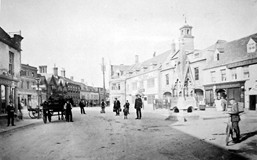 |
 |
The
car has been the major factor in changes to our towns, turning
them into chaotic places whereas once it was a pleasure to be
out and about. This tranquil scene in West Street is a
reminder of the peaceful urban life we have lost. |
|
One of the
more secluded spots in Bourne is Church Walk, always a favourite
with walkers, although the trees have been replaced over the years
and iron railings now line the bank of the Bourne Eau. |
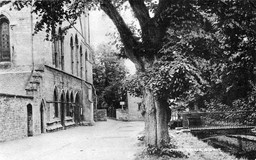 |
|
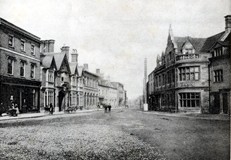 |
|
Street scenes from the past are a timely reminder of how the
motor car has ruined our town centres and this picture
demonstrates that two lads can stand in the middle of the road
without fear of being knocked down by passing traffic. |
|
|
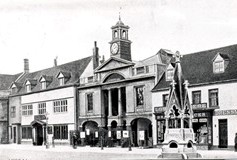 |
|
The
Town Hall once had a clock tower and iron railings across the
frontage, usually plastered with posters, but both features
have now gone, although it has remained the centre of civic
administration for almost two centuries. |
|
| |
|
Water mills
were once an essential part of our commercial life and Notley's Mill
in Victoria Place, which dated from the early 18th century, was an
imposing building that survived until 1973 when it was closed and
demolished. |
 |
|
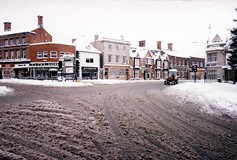 |
One of the
heaviest snowfalls of recent times occurred in January 1987 when the
town was covered to a depth of 6-12 inches. The main A15 was blocked
and bus services halted while the inevitable thaw brought flooding
to several streets. |
|
Flooding was a constant problem for Bourne in past times and
in 1912, many places in and around the town were under water
after a spell of continual rain such as the Spalding Road
where one intrepid motorist refused to be deterred. |
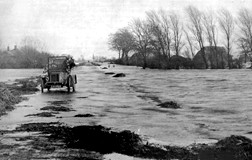 |
|
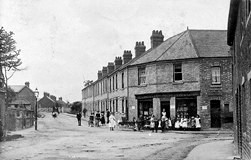 |
Assorted children flocked to be in this photograph taken
outside two corner shops in the Austerby, one of them dealing
in fancy goods and the other occupied the local plumber who
also worked as a paper
hanger, painter, decorator and glazier. |
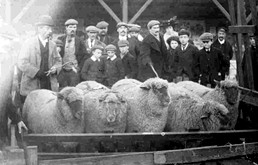 |
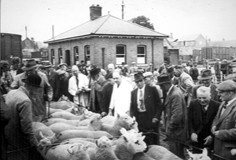 |
|
The cattle market in Bourne is remembered by older residents
as a centre for livestock sales, a meeting place for old
friends and a great deal of gossip. It closed in 1981 and the site
was cleared to make way for the Burghley Arcade development. |
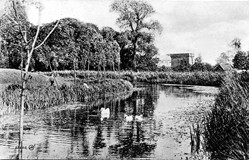 |
The Bourne
Eau was a much wider and deeper river in past times and from the
bank of the so-called moat section in which is now the Wellhead
Gardens the water tower from the railway sidings could be seen in the
distance. |
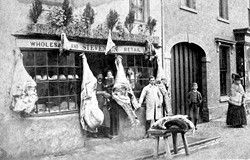 |
|
Our
meat today comes neatly packaged with little sign of its
origins but in past times it was cut straight from the carcass
that had often been hanging outside the butcher's shop such as
here in West Street in the late 19th century. |
|
|
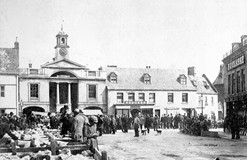 |
|
Traffic now dominates the town centre but there was a time
when animals took precedence, especially on market days when farmers
and dealers flocked in to buy and sell from special pens erected
down the middle of the street. |
|
|
The
increase in traffic flows around Bourne is best illustrated by
old photographs which reflect a more leisurely pace of life
such as here in West Road showing a deserted junction where
the Stamford road meets what is now the A151. |
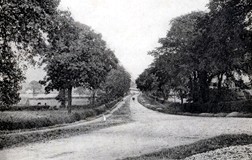 |
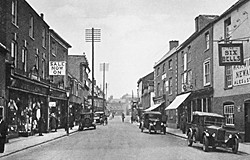 |
The
town centre has undergone dramatic changes in the past 100
years notably as a result of the increasing amount of traffic
which has transformed North Street into a main through road
where vehicle flows often cause lengthy delays.
|
|
There
was once a level crossing and a signal box in South Street
where the line crossed the main road but both were dismantled
when the railway age for Bourne ended in 1965 after more that
a century of brisk business. |
 |
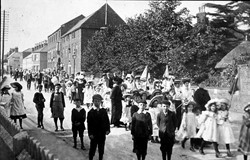 |
|
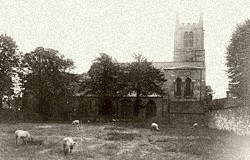 |
|
A
march through the streets headed by the town's brass band
always marked the annual treat for children from the
Congregational Church in Eastgate which ended with games and a
picnic at the Park Field in the Austerby. |
|
Sheep may
safely graze has been a Christian observance for centuries and here
they can be seen enjoying the grass outside the Abbey Church in a
meadow that has been occupied since 1986 by the vicarage and its
adjoining garden. |
 |
The
railway was once an important link with Bourne and the station was situated
at the Red Hall that has survived the vibrations from steam
locomotives and rolling stock which ran past the building for
almost 100 years. |
|
The
arrival of the motor car has transformed our roads which are
now a mass of lines and signs but there was a time when even a
solitary vehicle was a rare sight such as here in West Road
before it became a residential area busy with traffic. |
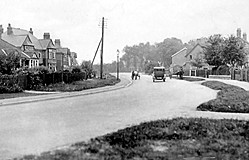 |

Go to:
Main Index Villages
Index
|